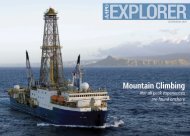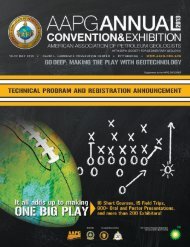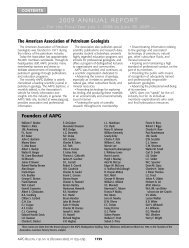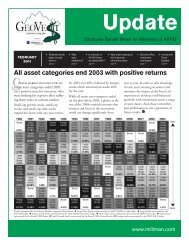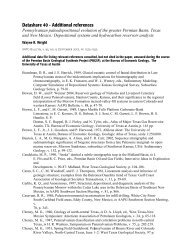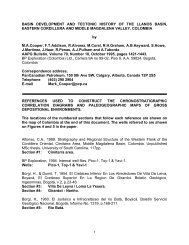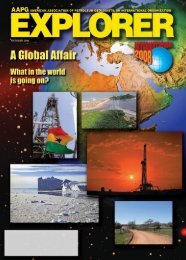Download - American Association of Petroleum Geologists
Download - American Association of Petroleum Geologists
Download - American Association of Petroleum Geologists
Create successful ePaper yourself
Turn your PDF publications into a flip-book with our unique Google optimized e-Paper software.
AAPG<br />
EXPLORER<br />
Zagorski<br />
from page 32<br />
led him to earn his master’s degree at the<br />
University <strong>of</strong> Pittsburgh.<br />
In 1992, Lomak <strong>Petroleum</strong> Inc. acquired<br />
Mark Resources. Zagorski eventually<br />
became manager <strong>of</strong> geology for Lomak,<br />
which later became Range Resources<br />
Corp.<br />
He generated prospects in numerous<br />
areas and formations, including a regional<br />
unconventional play targeting the Trenton/<br />
Black River Formation in New York, which<br />
led to Utica/Trenton discoveries in the Clyde<br />
Field.<br />
His interest in the Trenton Black River<br />
play grew out <strong>of</strong> regional studies related to<br />
expanding several new high volume gas<br />
discoveries being made in West Virginia<br />
ZAGORSKI<br />
and south central New York, which were<br />
attracting significant industry interest.<br />
“Although the Trenton Black River play<br />
had been extensively developed early for oil<br />
in the giant Lima Indiana field, that play had<br />
not been successfully tested in the deeper<br />
part <strong>of</strong> the Appalachian Basin,” he said.<br />
“We ended up in 2000 putting together<br />
a couple <strong>of</strong> acreage blocks down here in<br />
southern Pennsylvania to test these deeper<br />
reservoir concepts.”<br />
“I had something new to<br />
bring back to the company<br />
– we had our own Barnett<br />
Shale-style play here.”<br />
‘A Barnett Shale Equivalent’<br />
In 2003, Zagorski and his colleagues<br />
identified a large, untested domal structure<br />
in Washington County, Pa.<br />
“Back at that time most <strong>of</strong> the<br />
conventional wisdom on the Marcellus was<br />
that it couldn’t be developed commercially.<br />
It wasn’t in everyone’s psyche to be looking<br />
at that play,” he said. “We wanted to drill<br />
a formation that was shallower than the<br />
Trenton/Black River but deeper than the<br />
Marcellus on this structure.”<br />
In 2003, Range Resources drilled a<br />
well, the Renz Unit #1, to test the structure.<br />
While significant shows were encountered,<br />
attempts to complete and commercialize<br />
these deeper zones failed, and the<br />
company was preparing to plug and<br />
abandon the well.<br />
Zagorski thought the prospect still had<br />
possibilities.<br />
He was right. The Renz later became<br />
famous as the start <strong>of</strong> the Marcellus Shale<br />
play.<br />
“In 2004 I went to visit a geologist in<br />
Houston (Gary Kornegay) I’d worked with<br />
years before in Utah’s Uinta Basin,” Zagorski<br />
recalled. “He had a prospect he wanted<br />
me to look at in the Neal/Floyd Shale in the<br />
Black Warrior Basin in Alabama,” Zagorski<br />
recalled.<br />
Part <strong>of</strong> the prospect pitch included a<br />
comparison <strong>of</strong> the Floyd as an analog to the<br />
Barnett Shale.<br />
“At that time I hardly knew what the<br />
Barnett Shale was,” Zagorski said.<br />
He soon found out, and similarities to the<br />
Marcellus were striking.<br />
“That was the point in time I had the<br />
‘Holy smokes!’ moment,” he said. “I<br />
had something new to bring back to the<br />
company – we had our own Barnett Shalestyle<br />
play here.”<br />
Zagorski said he took the concept to<br />
then-Range Resources CEO Jeffery L.<br />
Ventura, a seasoned petroleum engineer<br />
with both domestic and international<br />
experience, who gave the project and<br />
completion recommendation a green light.<br />
The company went back to the Renz well<br />
and tried a large, Barnett-style hydr<strong>of</strong>rac in<br />
the Marcellus.<br />
Resulting gas production for this first<br />
vertical test started at around 300,000 cubic<br />
feet a day (mcf/day), later topping out at<br />
800,000 cubic feet a day (mcf/day), he said.<br />
“That opened our eyes. What we did<br />
then was to take a look at the formation a<br />
heck <strong>of</strong> a lot closer than we had before,”<br />
Zagorski said. “We ended up drilling two<br />
more vertical confirmation wells. Then we<br />
began drilling our first horizontal well in late<br />
2004, 2005. That wasn’t any fun.<br />
“Now the hard part started.”<br />
The Dream Comes True<br />
Recognizing the Marcellus’ potential,<br />
Range Resources began leasing<br />
aggressively in southern Pennsylvania to<br />
add to its existing acreage positions. The<br />
company’s Marcellus team drilled and<br />
completed its first horizontal test in early<br />
2006.<br />
“It wasn’t as good as the vertical,”<br />
Zagorski said. “The second didn’t get any<br />
gas. The third was twice as good as the<br />
first, but still not as good as we needed to<br />
establish commerciality.”<br />
Time was going by and costs were<br />
piling up.<br />
He credits Ventura with the long-term<br />
vision to continually support and steer the<br />
project, saying, “The senior guy was behind<br />
the play from the very start.<br />
“Jeff had a vision to transform Range<br />
from a traditional exploration company to<br />
one focusing on resource plays that were<br />
highly repeatable and <strong>of</strong>fered large scale<br />
development,” he added, “so the Marcellus<br />
really fit perfectly for his vision.”<br />
Ventura will tell his own story about the<br />
challenges <strong>of</strong> the Marcellus as he is the<br />
keynote speaker for the Michel T. Halbouty<br />
Lecture at ACE 2013 on May 20.<br />
In 2007, they took what they had<br />
learned from the first three horizontal tests<br />
34 MAY 2013 WWW.AAPG.ORG<br />
See Marcellus, page 38



